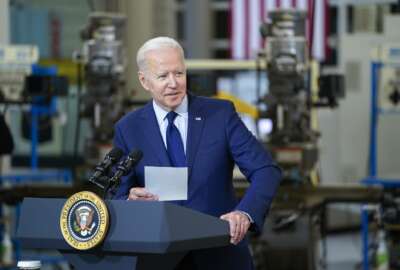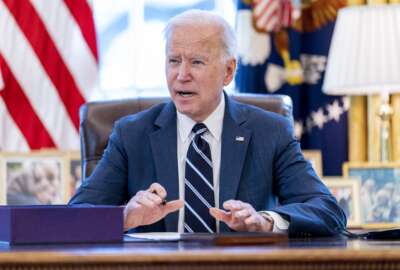Treasury wants to join the growing ranks of agencies with IT working capital funds
The White House’s fiscal 2023 budget request includes $65 billion for federal civilian IT spending, including big increases for DHS, OPM and SBA.
CORRECTION: Treasury, USAID and Labor do not have MGT Act IT-WCF, but have requested authority for the fund in 2023.
December will mark the fifth anniversary of President Donald Trump signing the Modernizing Government Technology Act into law.
While many in government and industry still love to focus on the Technology Modernization Fund as a big win from that bill, the ability to create IT working capital funds will, over the long term, be former Rep. Will Hurd’s (R-Texas), Reps. Gerry Connolly’s (D-Va.) and Robin Kelly (D-Ill.) true crowning achievement.
It’s clear today that Hurd, Kelly and Connolly overestimated the appropriators’ enthusiasm for and acceptance of IT WCFs. Only a handful of agencies have been able to convince House and Senate money managers to approve these bank accounts, and most agency CFOs have been reluctant to just set these rainy funds up without prior approval.
And like with most things on Capitol Hill, change comes slowly, but it does come.
The latest example comes in President Joe Biden’s fiscal 2023 budget request to Congress.
The number of IT WCFs is growing, albeit much more slowly than is needed to address $7 billion or more in technical debt across the government.
The Treasury Department is the latest agency to ask lawmakers grant them the ability to create an IT working capital fund. The agency would like to retain up to 5% of its appropriation to this new bank account and it can remain available until Sept. 30, 2026.
Treasury, at least at the headquarter level, has been a cautious mover to the cloud, and many expect its modernization effort to pick up steam with the impending award of the T-Cloud program, which seeks to establish a Treasurywide set of cloud services through multiple providers.
2 MGT Act working capital funds
There still are only two agencies with specific IT working capital funds using authorities under the MGT Act. The Small Business Administration, which was first, and the Office of Personnel Management received appropriators’ blessings.
The budget request details how much money, or at least, what percentage they hope to have in their accounts.
Labor, for example, expects to spend its $3 million if it receives approval for a IT WCF this year.
USAID would expects to have up to 5% or $30 million available pulled from six different accounts. The money also will be available for three fiscal years.
OPM and SBA plan to use the IT-WCF authority this year. OPM can save up to 5% of their extra funding into the IT WCF account, and it will be available through Sept. 30, 2026.
SBA said it will retain up to 3% of its funds from two different accounts and it will be available through Sept. 30, 2026.
Other agencies such as the departments of Education and Commerce also have requested IT WCF authority over the years, but haven’t received approval.
HUD, EPA also funding IT modernization
Along with these specific IT WCF, several other agencies also are putting money in existing working capital funds to address IT modernization.
The Department of Housing and Urban Development has an IT fund for “the development, modernization and enhancement of, modifications to, and infrastructure for departmentwide and program-specific information technology systems, for the continuing operation and maintenance of both departmentwide and program-specific information systems, and for program-related maintenance activities…”
HUD said in the budget that it expects to have $382 million, of which $339 million will be available to Sept. 30, 2024 and $43 million will be available through Sept. 30, 2026, which seems to connect back to the MGT Act.
The Environment Protection Agency is taking a similar approach to HUD.
It’s using a working capital fund created in 1997 and the authorities under the MGT Act to modernize IT services, including “agency postage costs, Cincinnati voice services, background investigations and enterprise human resources IT services managed by the Office of Mission Support; financial and administrative systems, employee relocations and a budget formulation system managed by the Office of the Chief Financial Officer; the Agency’s Continuity of Operations (COOP) site managed by the Office of Land and Emergency Management; legal services managed by the Office of General Counsel; regional information technology service and support managed by EPA Region 8; and multimedia and agency servicing contracts managed by the Office of the Administrator.”
EPA expects to have $414 million in the WCF in 2023.
The Department of Homeland Security is dissolving its working capital fund and instead “will transfer funds to the servicing management lines of business for fee-for-service and governmentwide mandated services.” DHS says it still expects to have $139 million in the working capital fund in 2023 as it liquidates pre-existing obligations that occurred against the fund and wind down activities.
Aside from working capital funds, the White House offered mixed support for IT modernization.
Overall IT spending for civilian agencies would rise to $65.8 billion in 2023 from $58.4 billion this year. OPM, SBA and DHS are among the biggest winners with significant increases in funding requests.
Meanwhile, the Office of Management and Budget requested “only” $300 million for the TMF. This is down from $500 million it requested in the 2022 budget. But the lower request comes after Congress zeroed out the TMF in the 2022 omnibus bill, citing needing to spend the remaining $700 million currently in the TMF, most of which came from the American Rescue Plan Act.
“With the continuously evolving IT and cyber landscape, these investments are an important down payment on delivering modern and secure services to the American public, and continued investment in IT will be necessary to ensure the United States meets the accelerated pace of modernization,” OMB wrote in the budget request.
OMB, GSA’s other IT funds to see boost
But two other related IT modernization funds would see boosts in 2023.
OMB’s IT Oversight and Reform Fund (ITOR) asked for $14 million in 2023, up from $12 million. The U.S. Digital Service, which like the TMF benefited from a windfall in the American Rescue Plan Act of $200 million, asked for no new funding.
Congress approved $8 million for the ITOR fund in 2022.
USDS is using the ARPA money to increase its full-time employees to 271 in 2022, up from 161 the year before. It says the larger number of employees will enable “USDS to quickly address technology emergencies, ensure access and equity are integrated into products and processes, and help agencies modernize their systems for long-term stability.”
At the General Services Administration, the administration is seeking a huge increase for Federal Citizen Services Fund to $115.8 million. GSA requested $59.2 million in 2022 and $58.4 million in 2021.
Congress approved $55 million in 2022.
Additionally, GSA’s Office of Governmentwide Policy is seeking a modest increase to $70 million, from $68.7 million that Congress allocated in 2022.
GSA says it also would spend $12 million on the acquisition workforce training fund and $10.9 million would go into a working capital fund to continue the e-rulemaking modernization project.
Beyond the funding requests, OMB also laid out some policy objectives in the budget.
After being fairly quiet over the last two years, OMB re-initiated the concept of shared services.
Along with the Quality Service Management Office efforts at the Cybersecurity and Infrastructure Security Agency (CISA), which were most active over the last few years, OMB says the Grants Management QSMO, led by the Department of Health and Human Services, released its initial marketplace in fiscal 2021, identifying a dozen systems.
“The Grants QSMO is now working to verify that the functionality of these systems is consistent with the agreed to grants standards,” the budget states. “The remaining QSMOs are working to release their marketplaces as soon as possible, potentially as early as fiscal 2023.”
Of course, all of these figures are just that and lawmakers will take this request and do what they will with them. This is why the more agencies who receive permission for the IT-WCF will have a better chance of getting out of technical debt and delivering modern services to citizens and businesses.
Copyright © 2025 Federal News Network. All rights reserved. This website is not intended for users located within the European Economic Area.
Jason Miller is executive editor of Federal News Network and directs news coverage on the people, policy and programs of the federal government.
Follow @jmillerWFED






